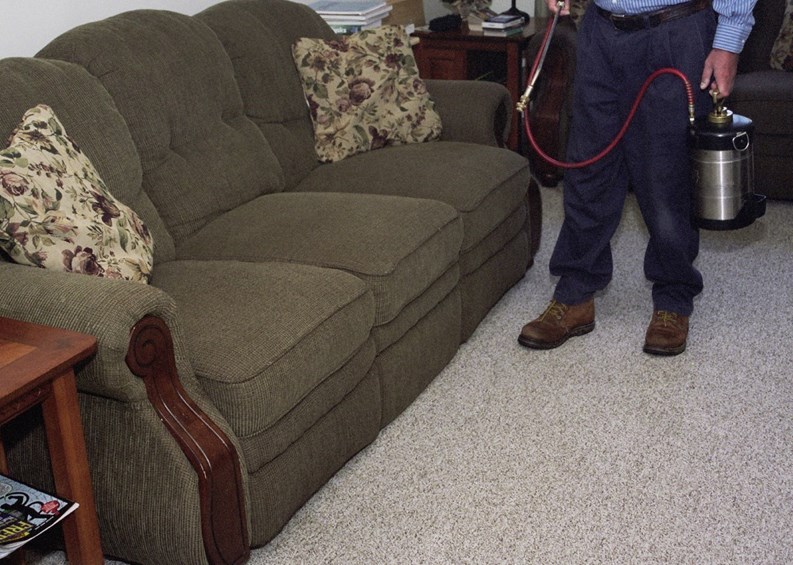Bugs, rodents, and other pests are always a potential problem in a city or densely populated suburban area—and even upscale, well-maintained buildings are not impervious to the occasional unwelcome interloper. Cockroaches invade kitchens, termites feast on foundations and walls, bees sting humans, and now bedbugs have hogged the press as the latest plague du jour. No two ways about it: if your property falls behind on the pest-control front, you’ve got yourself a menagerie.
Some pest issues are year-round—like the aforementioned bedbugs, who can show up whenever a new mattress is delivered, regardless of the season—but there is a seasonal pattern to most. So seasonal, in fact, that exterminators routinely service their client properties at quarterly intervals.
“We have a pest calendar,” explains Jerry Smith, co-owner of Dial Pest Control in Roseland, New Jersey. “In our region, most of the property managers go to bid with quarterly service—that’s in line with the four seasons. In Florida, it’s monthly.”
It can also be monthly in New York and New Jersey too, if the living quarters are especially close. “Associations should have service year-round,” advises Mike Comune, owner of Pest Pros Inc. in Toms River, New Jersey. “You’re dealing with multiple apartments or condos. You have a complaint log, and the guy comes once a month to take care of them.”
However frequently your building is serviced, problematic critters themselves tend to have seasonal patterns, so it may be helpful to discuss pest control as a seasonal project that changes as the year goes on.
The Fall of Man
We begin in mid-autumn. The heat of the summer wanes, the mercury plummets, frost coats windows and sidewalks—and mice move from their outdoor homes to warmer redoubts inside. Despite their furry coats, mice are extremely sensitive to cold. They have even been known to freeze to death on summer nights if not safely burrowed away.
“This time of year is more for rodent control,” says Smith. “[Rats and] mice look to spend their days in a warmer environment.”
The Superhero-like qualities of both mice and rats are well documented. They can scale walls. They can gnaw through almost anything short of concrete. A coin-sized hole is large enough for them to squeeze through. They live in groups, and they are methodical, following the same path around their area every day, like doctors making rounds at a hospital. Unlike doctors at a hospital however, rodents can be a real health hazard.
“They urinate as they run along,” says Comune. “If you used a black light [to see their trail], you’d be shocked.”
How can you tell your building has a rodent situation? Their droppings—little black pellets that look like fat chocolate ice cream sprinkles—are always a giveaway. So is evidence of gnawing and burrowing—holes in walls, or outside in tree-pits or plantings near your building are sure signs. And the noise—the infernal scratching noise from behind the walls, which drives both housecats and apartment owners crazy, is another indication that your building is hosting unwanted guests. “Quiet as a mouse” is not the most accurate idiomatic expression.
Less common than rodents but not unheard of in urban settings are bats. Contrary to popular belief, bats are not simply “mice with wings.” They are actually more like cats. They are solitary, clean, methodical—and they are great hunters. In the summertime, a bat can eat about 600 mosquitoes per hour. While that talent doesn’t do much good in an attic or rooftop garden, it does serve a very useful purpose if your residents enjoy making use of your building’s outdoor space in the summer and don’t like the smell of citronella-scented bug repellent candles.
The autumn is also the tail end of the spider-breeding season. “There’s lots of web building and construction then,” says Smith—and not of the World Wide variety. Spiders, like bats, tend to lurk in dark corners. They also kill other insects, which is good, but unlike bats, they spin webs—and they occasionally bite people.
The Winter of Our Discontent
While winter tends to be a quieter time for critters, it’s by no means totally pest-free. In fact, colder months are often when apartment-dwellers notice more rogue agents making forays into their territory.
According to Greg Zarek of Metro Pest Control Inc. in Glendale, pests infiltrate our homes for the same reason we spend time there: for food and shelter. Some pests simply opt to stay inside rather than venture out to forage for food. “People tend to see pests more when they winter in a building for warmth,” says Zarek. “That applies to rats and mice, too.”
According to Nana Kojo Ayesu, owner of Kojo’s Pest Elimination Service in the Bronx, the key to keeping your co-op or condo building pest-free during the dead of winter is to inspect for pests that are trying to find a safe, warm place to hide during the cold months. To keep them out, Kojo advises boards to seal cracks, crevices and areas where utilities enter buildings or units. Repair leaking pipes and other areas where excess water may build up
And as always, neatness counts—get rid of places offering nooks, crannies, and cover from predators, and you can significantly reduce (and maybe even eliminate) your pest problem. This can be achieved by clearing clutter in areas like garages, storage areas, and basements that could harbor pests.
Assuming a building has taken appropriate steps to pest-proof themselves before the cold hits, “There’s a dormant period for us in winter,” says Smith of the extermination trade,” and a rebirth in the spring.”
Spring Into Action
Spring means bugs. “When green stuff comes off the trees, when leaves emerge, when your car windshield is covered with pollen—that’s the birth of the insect world,” says Smith. “That’s a celebration in the insect world.”
It is almost inevitable that your building will have a problem with some type of insect or other at some point along the line—they do outnumber us humans by many orders of magnitude.
While more suburban homeowners have to contend with pests like carpenter ants, termites, and swarms of mosquitoes—especially in swampy or marshy areas near water—there are plenty of more urban pests that don’t conform to a seasonal schedule as easily. Cockroaches can supposedly survive a nuclear bomb—the radiation doesn’t affect them. (Doesn’t that make you feel safe?) And a cockroach infestation can be especially detrimental to your health.
“Roaches are the biggest health hazard,” says Comune. “They’ve been linked to so many health problems.” Like asthma, just to name one potentially deadly example.
Also high on the “fear factor” scale are bedbugs, which have been enjoying a resurgence in the region in recent years. Bedbugs attack indiscriminately, whether in shoddy flats, Eurorail sleeper cars, or five-star Manhattan hotels. They sometimes come when a new mattress is delivered, Comune says—a little extra residents usually don’t count on.
Although being bitten by parasites in your sleep is definitely gross, and bedbug related complaints are on the rise in New York City and other metropolitan areas, there is some consolation. Disgusting as they are, bedbugs are more or less harmless, Comune says. “You get eaten alive, and they’re ugly—but they don’t pose a health risk.”
Protection Inside & Out
Fortunately, exterminators can handle all of these pests and others, and they’ve got an arsenal of weapons to use against them, including spraying, trapping and baiting, just to name a few. With bugs, most of the work is done outside the building. With mice and other rodents, it comes inside.
“We do what’s called IPMs—Integrated Pest Management,” says Joe Ippolito, the technical director of Eastern Pest Management, which is based in Newburgh and services co-ops and condos throughout the tri-state area. “We try to exclude the pests [from the building] before we trap them.”
In many cases, creepy crawlies plague us regardless of the circumstances, because of the changes in the weather. Even the best exterminator can’t kill every undesirable creature within a football throw of your property. But there are some causes that are not natural.
“It has to do with lifestyles,” says Comune. “In a city, you’re in close quarters with so many different kinds of people, so many different lifestyles. You have one or two units with roaches or bedbugs, and it spreads.”
By “lifestyles,” he doesn’t mean how an apartment occupant dresses, if they drink, or how they spend their free time. He means something simpler.
“It’s the way they live,” Comune says. “The way they store products and food. The way they store their garbage. Do they have animals and pets? Do they leave food out?”
Whatever the weather, whatever the season, pest control is an issue that every building must address periodically. The best-prepared communities have a game plan in place before problems arise, and do their best to educate residents about what they can do as individuals to reduce the likelihood that their building will play host to annoying or potentially dangerous pest infestations.
Greg Olear is a freelance writer and a frequent contributor toThe Cooperator.







Leave a Comment